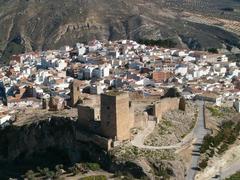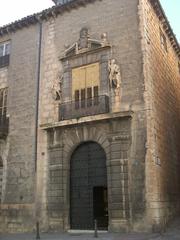Castillo de Santa Catalina: Visiting Hours, Tickets, and Historical Sites in Jaén
Date: 03/07/2025
Introduction
Perched atop the commanding Cerro de Santa Catalina, the Castillo de Santa Catalina is Jaén’s most iconic historical landmark. This majestic fortress, visible from almost every corner of the city, offers visitors a journey through more than a millennium of Andalusian history. From its origins as a Moorish stronghold, through its transformation under Christian rule, to its modern role as a cultural hub and hotel, the castle seamlessly fuses historical depth, architectural grandeur, and breathtaking panoramas.
This detailed guide presents everything you need to know for your visit: opening hours, ticketing, accessibility, travel tips, event highlights, and more. Whether you’re a history aficionado, a photographer, or simply exploring Andalusia, the Castillo de Santa Catalina promises an enriching experience (Isolated Traveller, Extra Jaén, Nomads Travel Guide).
Table of Contents
- Historical Overview
- Visiting Information
- Architectural Highlights
- Special Events and Experiences
- Nearby Attractions
- FAQ
- Visuals and Media
- Conclusion and Call to Action
- References
Historical Overview
Moorish Foundations
The roots of Castillo de Santa Catalina reach back to the 8th and 9th centuries, when Muslim rulers fortified the Cerro de Santa Catalina as a defensive outpost on the frontier of Al-Andalus. The original fortress, known as the Alcázar Viejo, featured thick stone walls, watchtowers, and palatial quarters, serving as both a military bastion and a seat of power (Isolated Traveller). Its elevated vantage point enabled surveillance over the Guadalquivir valley and rapid communication with other outposts through signal fires.
Christian Reconquest and Expansion
In 1246, the city and its fortress were surrendered to King Ferdinand III of Castile, marking the end of Muslim rule in Jaén. The Christians swiftly initiated major reconstruction, erecting the Alcázar Nuevo and reinforcing the defensive system with prominent towers like the Torre del Homenaje. The castle became both a strategic military garrison and a symbol of Christian authority (Extra Jaén). Religious elements, such as the chapel dedicated to Santa Catalina of Alexandria, were integrated, and the castle was named in her honor.
Renaissance, Napoleonic, and Modern Adaptations
Over the centuries, the castle was modified to adapt to new military technologies, especially during the Renaissance, when artillery platforms and reinforced walls were added. During the Peninsular War, Napoleonic troops occupied the fortress, adapting its spaces for logistics and defense. The 20th century saw restoration efforts, including the construction of the Parador de Jaén, a luxury hotel within the castle, which preserved and revitalized the site for tourism and cultural events (Isolated Traveller).
Cultural Significance and Living History
Today, Castillo de Santa Catalina is not only a monument but also a living center of Jaén’s culture. In 2025, theatrical reenactments under the theme “1200 años de vidas en el Castillo” will bring its history to life, with actors portraying key historical figures and dramatizing pivotal events (Extra Jaén). The monumental cross atop the hill, echoing the one placed by Ferdinand III, remains a focal point for visitors and locals alike.
Visiting Information
Hours and Ticketing
- Opening Hours:
- Tuesday to Sunday: 10:00 AM – 6:00 PM
- Closed Mondays and certain public holidays.
- Summer hours may extend to 7:00 PM; check the official tourism site for updates.
- Ticket Prices:
- Adults: €3.50–€6 (varies by source and tour type)
- Students, seniors, children (6–12): €1.50–€3
- Children under 6: Free
- Guided tours (90 min): ~€12.75 per person
- Tickets are available at the entrance or online (Travelling Jezebel)
Accessibility
- The main courtyard and visitor center are wheelchair accessible; some towers and upper levels are not due to historical constraints.
- Ramps and adapted paths are provided where possible; assistance is available at the entrance.
- Families with children should supervise closely due to uneven terrain and steep drops (Nomads Travel Guide).
Travel and Accommodation Tips
- Getting There:
- By car: Free parking near the entrance, well-signposted from Jaén center
- By taxi: Readily available in Jaén
- On foot: Scenic one-hour hike from the city center
- By bus: Infrequent; check with the tourist office
- Where to Stay:
- Parador de Jaén: Stay in medieval ambiance with modern comforts
- City hotels: Options like Hotel Xauen and Hotel Condestable Iranzo offer central access
Visitor Facilities
- Visitor Center: Interactive exhibits and historical displays
- Restrooms and Gift Shop: On-site
- Dining: Restaurant at the Parador de Jaén next door, featuring Andalusian specialties
Architectural Highlights
Towers, Walls, and Defensive Features
The castle’s triangular layout, robust limestone walls, and six defensive towers showcase centuries of military engineering (Castlepedia). The Torre del Homenaje dominates the skyline, while features like secret doors and the Torre de las Troneras (with its historical latrine) point to both defensive ingenuity and daily life.
Panoramic Viewpoints
The ramparts boast sweeping views over Jaén, the Guadalquivir valley, and distant ranges. The Cruz del Castillo, a short stroll from the main fortress, is a favorite spot for reflection, sunset views, and photography (Sobre Turismo).
Gardens and Landscape Integration
The castle is surrounded by tranquil forests and gardens, historically used for food and medicinal plants, now offering walking trails and peaceful retreats (Castlepedia).
Special Events and Experiences
- Theatrical Reenactments (2025):
“1200 años de vidas en el Castillo” – Monthly immersive performances dramatizing major chapters in the castle’s history (Extra Jaén). - Guided Tours:
Daily in Spanish, with English options; include access to towers, dungeons, and kitchens. - Cultural Events:
Medieval fairs, concerts, exhibitions, and more throughout the year.
Nearby Attractions
- Jaén Cathedral: Renaissance masterpiece, a short stroll from the castle
- Arab Baths: One of Spain’s best-preserved hammams
- Museums: Provincial Museum of Jaén, Museum of Arts and Popular Traditions
Day trips from Jaén include Granada, Córdoba, and the Cazorla and Segura mountains (Nomads Travel Guide).
FAQ
Q: What are the Castillo de Santa Catalina visiting hours?
A: Typically, 10:00–18:00 (summer), 10:00–17:00 (winter), closed Mondays.
Q: How do I buy tickets?
A: At the entrance or online via the official tourism site.
Q: Is the castle accessible for people with reduced mobility?
A: Main areas are accessible, but towers and ramparts may be difficult.
Q: Are guided tours available?
A: Yes, in Spanish and English, including access to restricted areas.
Q: Can I dine at the castle?
A: The castle itself has no café, but the adjacent Parador hotel offers an acclaimed restaurant.
Visuals and Media

Alt text: Entrance of Castillo de Santa Catalina with ticket office and visitor center.
Alt text: Panoramic view of Jaén city from the ramparts of Castillo de Santa Catalina. Alt text: Torre de las Damas, Castillo de Santa Catalina - panoramic views.
For virtual tours, interactive maps, and additional images, explore the official tourism website and trusted travel guides.
Conclusion and Call to Action
The Castillo de Santa Catalina stands as a living monument to Jaén’s storied past and vibrant present. Its commanding position, layered architecture, and dynamic programming create an unforgettable experience. Plan your visit by checking up-to-date hours and ticketing information, book a guided tour for deeper insight, and be sure to explore the adjacent Parador and nearby attractions.
Enhance your journey with the Audiala app for audio guides, interactive maps, and insider tips. Follow us on social media for event updates and travel inspiration.
Embark on your adventure to Castillo de Santa Catalina and immerse yourself in the heart of Andalusia’s heritage!
References
- Castillo de Santa Catalina: Visiting Hours, Tickets, and Historical Guide to Jaén’s Iconic Fortress, 2025, Isolated Traveller (Isolated Traveller)
- Castillo de Santa Catalina Architecture and Visitor Guide: History, Tours, and Viewing Tips, 2025, Castlepedia & Audiala (Castlepedia), (Audiala)
- Castillo de Santa Catalina Jaén: Visiting Hours, Tickets, and Historical Guide, 2025, Castillos y Fortalezas de Jaén & Visit Andalucia (Castillos y Fortalezas de Jaén), (Visit Andalucia)
- Visiting Castillo de Santa Catalina: Hours, Tickets, and Essential Tips for Exploring Jaén’s Historic Fortress, 2025, Nomads Travel Guide & Travelling Jezebel (Nomads Travel Guide), (Travelling Jezebel)
- Castillo de Santa Catalina Revival with Theatrical Visits, 2025, Extra Jaén (Extra Jaén)



